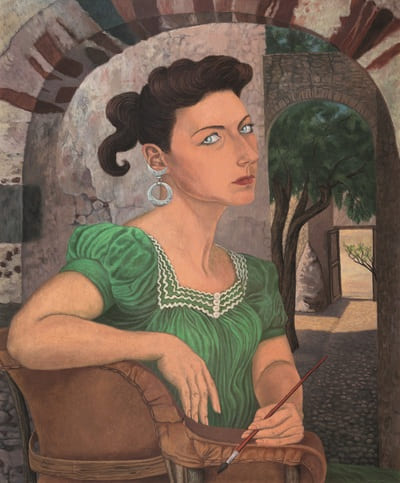
Olga Costa's forgotten painting
The work of this Mexican-German artist, a benchmark of Mexican modernism, is shown for the first time in Europe
One of the best known paintings by Olga Costa is The Fruit Seller, a colorful oil painting of a sturdy Indigenous vendor surrounded by baskets with more than 50 varieties of fruits and vegetables typical of Mexico: pineapple, mamey, sapotes, guanabanos, cherimoyas, bananas, watermelon, pears, pumpkins.....
The work, a public commission that the artist received in 1951, which today belongs to the Museum of Modern Art in Mexico City, is considered a reference of Mexican modernism and has even adorned the covers of first grade textbooks in the country. However, in Germany, the country where Costa was born, her work is still completely unknown.
For this reason, the Museum of Fine Arts Leipzig (MdbK) has just opened the first major exhibition in Europe dedicated to the Mexican artist of the last century, whose work stood out not only for her particular look when portraying the nature and landscapes of her adopted homeland — between fantastic and poetic — but also for the way she approached the challenge of embracing the Mexican identity through painting and reinventing herself as a woman artist in a much more macho and paternalistic culture than that of her country of origin.
The daughter of a Jewish-Ukrainian artist couple who left Odessa for Leipzig in search of better opportunities, Costa spent her early childhood in this Eastern German city until the family emigrated to Berlin and later to Mexico in 1925.
For Olga, then 13 years old, arriving in Mexico was like arriving in the promised land.
“A whole new world was revealed to her there,” said Sabine Hoffmann, curator of the exhibition. “She was fascinated by the colors, the people, the large murals that decorate Mexico City. In fact, she very quickly accepted her new home as her own.”
In Mexico, Costa grew up in the circle of intellectuals and artists in which her parents moved, and when she finished high school she enrolled in the National School of Plastic Arts to study painting, although she did not finish her studies. It was at the school where she met her future husband, artist and activist José Chávez Morado, whom she married in 1935. From then on, she began her career as a full-time self-taught painter and her ‘Mexicanization’ began. The first thing she did was to change her last name, Kostakowsky, to Costa, her artistic name.
RELATED CONTENT

A new identity
“When she was young, Costa identified with her new homeland and searched for a suitable form of artistic expression. This active and serious search is not, however, a linear process,” observes art historian Stefan Weppelmann in the exhibition catalog.
Her early works depict people from her surroundings and scenes from everyday life, as well as a keen interest in the customs and life of the Indigenous population, a hobby she shared with her husband, with whom she promoted the creation of pre-Hispanic art museums in the Guanajuato region.
Later, poetic impressions of nature dominate her artwork, where jewelry and artifacts from her personal collection of Indigenous art also seep in. Costa was trying to reaffirm his new Mexican identity through painting.
On the other hand, her work also served to reaffirm her as a woman artist. One of her earliest paintings, from 1934, is a self-portrait in which she appears in the center, brush in hand, dressed in a modern cut suit, blue eyes looking to the side, defiantly.
“This self-confidence is also reflected in her egalitarian relationship with her Mexican husband. Her famous colleague Frida Kahlo also has a marriage of equals. The fact that they both had German parents may be the reason for her emancipated attitude in the midst of the macho Mexican culture,” Hoffmann concludes.











LEAVE A COMMENT: